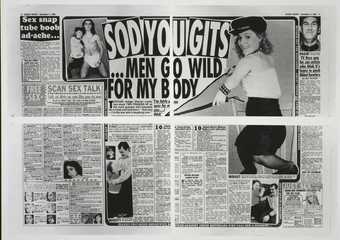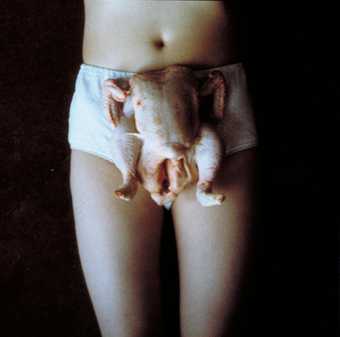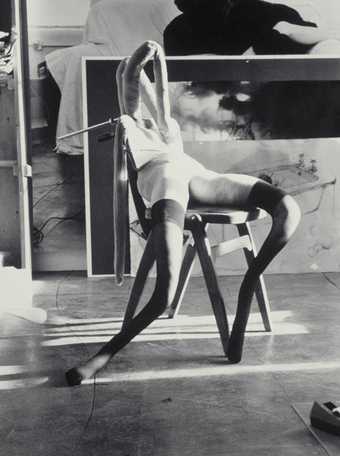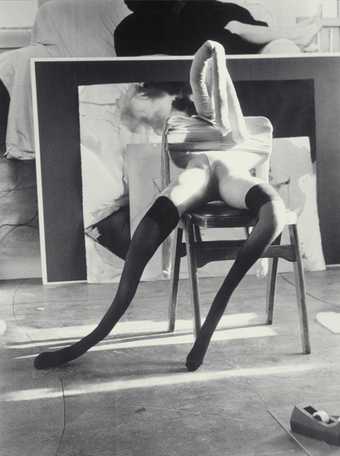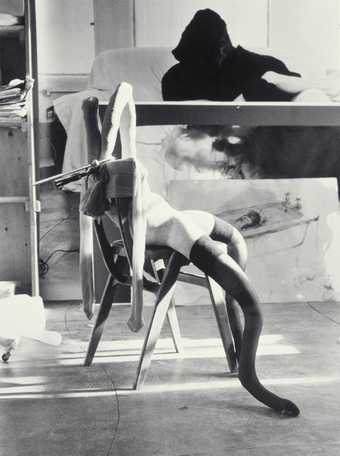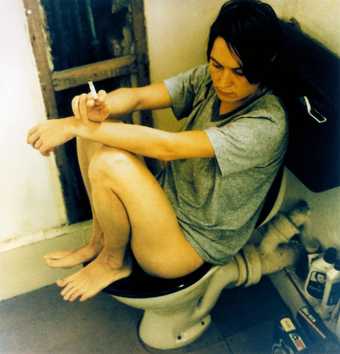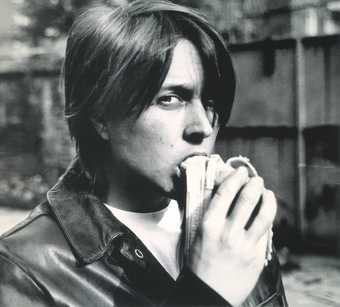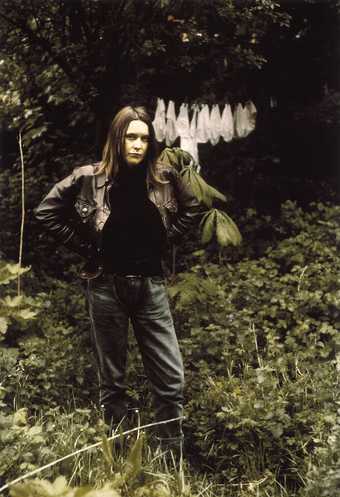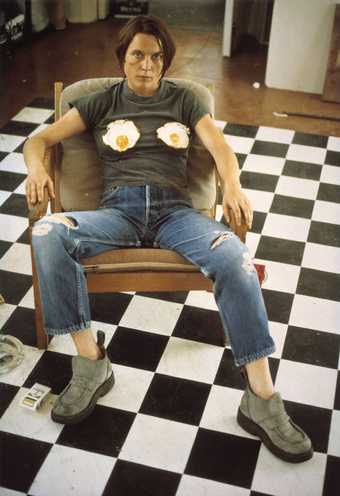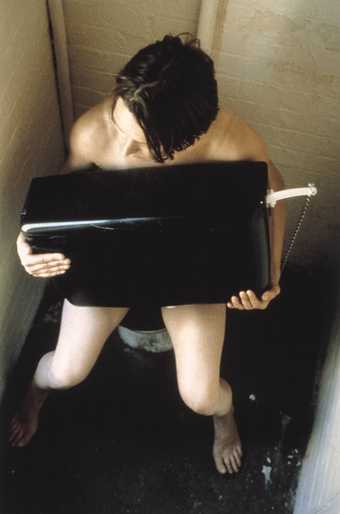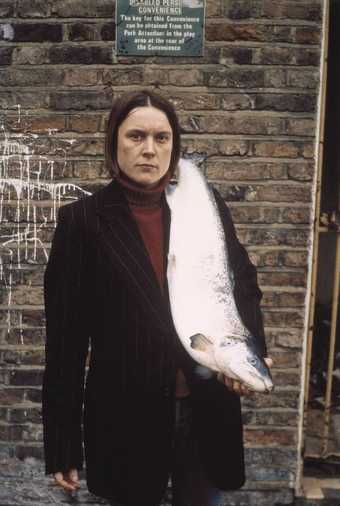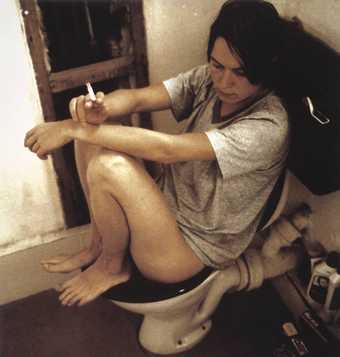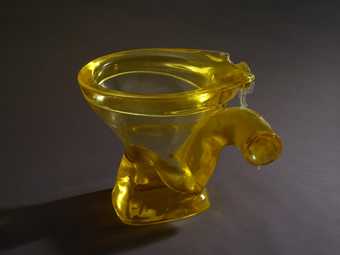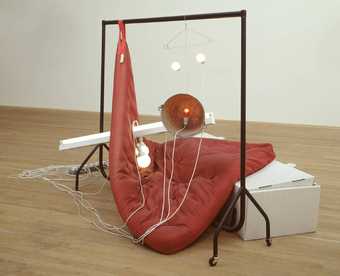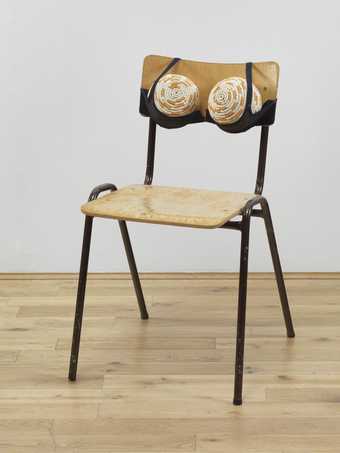
Not on display
- Artist
- Sarah Lucas born 1962
- Medium
- Wooden chair, vinyl seat, tights, kapok, metal wire, stockings and metal clamp
- Dimensions
- Object: 950 × 640 × 900 mm
- Collection
- Tate
- Acquisition
- Presented by the Patrons of New Art (Special Purchase Fund) through the Tate Gallery Foundation 1998
- Reference
- T07437
Summary
Presented by the Patrons of New Art (Special Purchase Fund) through the Tate Gallery Foundation 1998
T07437
Originally a component part of an installation and exhibition titled Bunny Gets Snookered, this is one of eight similar mannequins arranged on and around a snooker table at Sadie Coles HQ, London, in 1997. Black and White Bunnies (Tate P78227) are three black and white photographs of one of the mannequins which were included in the exhibition. Lucas stuffed variously coloured pairs of tights with cotton wadding to make 'bunny girl' forms, whose limply dangling arms and passively lolling legs provide a representation of abject femininity, in thrall to the arena of male virtuosity as suggested by the snooker table. Each 'bunny' wears differently coloured stockings corresponding to the colours in a set of snooker balls. Pauline Bunny, in its black stockings, corresponds to the highest value snooker ball. The black stockings are the most traditionally alluring of the selection of colours, connecting this representation of a woman to the image of a seductress. Any suggestion of power this might carry is subverted by the passivity of the floppy, stuffed body, which is clipped to an office chair, providing an emblem of secretarial submissiveness. The title of the installation reinforces the reading of disempowerment: to be snookered, in the language of the game of snooker, means to be prevented from scoring. This bunny girl is trapped by her femininity, only to be knocked against her fellow bunnies in a game of masculine skill.
The eight mannequins are individually titled Bunny, except Pauline Bunny, the skinniest of all the bunnies, which is named after Pauline Daley, assistant to Sadie Coles. This corresponds with Pauline Bunny's status as the most important and seductive of the bunnies, since contemporary fashion prefers the skinny female form. The artist had originally titled this work Bunny Gets Snookered #7 before retitling it in 2002.
Lucas specialises in challenging gender stereotypes through a play on conventions of representation and framing, specifically through the language and media of popular culture. The title of this piece suggests a lewd violation, a masculine victory in a sexual war. But the bunny's unhelpful slump, her sagging form and literal empty head (she has comic-strip stuffed 'ears' but the part of the tights which would logically be her head hangs empty) provide a comic antithesis to her traditional namesake and turn the desiring stereotype of masculinity back on itself. If femininity has been objectified, here it is that process of objectification itself which is revealed to be both comic and ridiculous, a self-defeating reduction which turns its object into something ultimately undesirable. Doll-representations of women trace a lineage from Surrealists such as Hans Bellmer (1902-75), through the assemblage-sculptures made by Ed Kienholz (1927-94) in the 1960s, to the photographs of Cindy Sherman (born 1954). Appropriating the macho vernacular of her working-class London background has provided Lucas with the means to critique the tradition of the male gaze in its own language.
Further reading:
Lynn Barber, 'Drag Queen', Observer Magazine, London, 30 January 2000, pp.10-16
Sarah Lucas, exhibition catalogue, Museum Boymans-van Beuningen, Rotterdam 1996
Minky Manky, exhibition catalogue, South London Gallery, London 1995, pp.2-5
Elizabeth Manchester
January 2000/September 2001/October 2002
Does this text contain inaccurate information or language that you feel we should improve or change? We would like to hear from you.
Display caption
This floppy figure relates to ‘bunny girl’ waitresses at Playboy clubs, whose uniform involves stockings and rabbit ears. Lucas’s version undermines any sense of glamour. It was originally exhibited with seven similar figures arranged around a snooker table. Their dangling limbs suggested powerless femininity, while the snooker table stood for masculine demonstrations of skill. Lucas draws on the language and imagery of her working-class London background to challenge the ‘male gaze’ that views merely women as sexual objects.
Gallery label, May 2019
Does this text contain inaccurate information or language that you feel we should improve or change? We would like to hear from you.
Explore
- abstraction(8,615)
-
- from recognisable sources(3,634)
-
- figure(2,270)
- formal qualities(12,454)
-
- found object / readymade(2,631)
- clothing and personal items(5,879)
-
- stocking(52)
- chair(915)
- social comment(6,584)
-
- gender(1,689)
You might like
-
Sarah Lucas Sod You Gits
1991 -
Sarah Lucas Chicken Knickers
1997 -
Sarah Lucas Black and White Bunny # 1
1997 -
Sarah Lucas Black and White Bunny # 2
1997 -
Sarah Lucas Black and White Bunny # 3
1997 -
Sarah Lucas Human Toilet Revisited
1998 -
Sarah Lucas Eating a Banana
1990 -
Sarah Lucas Self Portrait with Knickers
1994 -
Sarah Lucas Self Portrait with Fried Eggs
1996 -
Sarah Lucas Human Toilet II
1996 -
Sarah Lucas Got a Salmon On #3
1997 -
Sarah Lucas Human Toilet Revisited
1998 -
Sarah Lucas The Old In Out
1998 -
Sarah Lucas Beyond the Pleasure Principle (Freud)
2000 -
Sarah Lucas Cigarette Tits [Idealized Smokers Chest II]
1999

